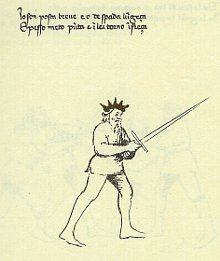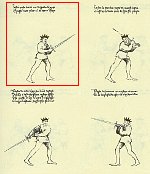| Fiore dei Liberi: Flos Duellatorum, 1410 (Pisani-Dossi, F. Novati, Bergamo, 1902) |
| 4 spada longa - longsword |
| 4.1.9 posta breve, stabile1 (short guard) |


Io son posta breve e ò de spada lungeça
Spresso meto punta e in lei torno in freça |
I am the short guard and of the longest sword
Is the fury of darting my point and quickly returning to it |
Synopsis: The couplet is written to imply that the sword has taken on qualities beyond its physical form, in that it can become a much longer sword with the posta breve. The second line of the couplet suggests that the posta breve can deliver a thrusting strike, like a "snake bite" and quickly return to its former position, without the need to move one's feet. The Getty's treatises asigns the term stabile which supports the notion of being able to deliver fast thrusts and return to the posta breve quickly without the need to move the feet.
Practical Application: The posta breve is perhaps the most common guard displayed by fighters, which suggests a very natural guard position. The structure of this guard is such that the blade is aligned to the line of attack between the wielder and the zugadore and the hilt is low and close to the wielder's belly. This structure creates a very strong defensive shield, which can be used to quickly deflect an inbound thrust returning with its own thrust to the zugadore entirely operating on the time of the hands. The point of the sword is oriented towards the face of the zugadore increasing its intimidation and therefore, offering greater opportunities to strike. This guard is able to be acquired with either the right foot forward or the left foot forward.
Footnotes
- stabile refers to posta that can be deployed (thrusts or cuts) simply through the extension of the hands and arms keeping footwork stationary. This info was derived from the Getty's version of Liberi's treatise.

